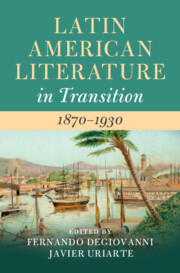Book contents
- Latin American Literature in Transition 1870–1930
- Latin American Literature in Transition
- Latin American Literature in Transition 1870–1930
- Copyright page
- Contents
- Figures
- Contributors
- Acknowledgments
- Introduction
- Part I Commodities
- Part II Networks
- Part III Uprisings
- Part IV Connectors
- Part V Cities
- Chapter 22 Iquique, Chile
- Chapter 23 Manaus, Brazil
- Chapter 24 San Juan, Puerto Rico
- Chapter 25 Ciudad Juárez-El Paso
- Index
- References
Chapter 24 - San Juan, Puerto Rico
from Part V - Cities
Published online by Cambridge University Press: 14 January 2023
- Latin American Literature in Transition 1870–1930
- Latin American Literature in Transition
- Latin American Literature in Transition 1870–1930
- Copyright page
- Contents
- Figures
- Contributors
- Acknowledgments
- Introduction
- Part I Commodities
- Part II Networks
- Part III Uprisings
- Part IV Connectors
- Part V Cities
- Chapter 22 Iquique, Chile
- Chapter 23 Manaus, Brazil
- Chapter 24 San Juan, Puerto Rico
- Chapter 25 Ciudad Juárez-El Paso
- Index
- References
Summary
For the criollo elite, the optimism regarding Puerto Rican progress outweighed any sense of heritage loss in the aftermath of the 1898 Spanish–American war. US authorities promised that a colonial moratorium on civilization and democracy would be raised. The old walled city, a symbol of claustrophobia and colonial despotism for some intellectuals, should be transformed into a metropolis. Spanish centenary fortifications and buildings should be torn down, places renovated, and the city grid expanded and embellished. Scorn for the old city, however, came to a halt along frustration. The endurance of colonial rule transformed San Juan into an uncanny landscape in which opposite European city ideas clashed with US urban pragmatism, the immediate with the transcendent, utopia with waste. This chapter addresses the spatial outcome of political transition between empires dominance and the twist in meanings of the old walled city, once reviled, later signified as national heritage.
Keywords
- Type
- Chapter
- Information
- Latin American Literature in Transition 1870–1930 , pp. 357 - 371Publisher: Cambridge University PressPrint publication year: 2022



